The Vive Pro 2 is HTC’s latest consumer oriented VR headset, replacing the Vive Pro. Priced at $799 just for the headset, it is one of the most expensive consumer VR headsets on the market, surpassing the price of the original HTC Vive Pro, the Valve Index, the HP Reverb G2, and even the Pimax Vision 5k Super. Is it worth such a big investment? Let’s find out.
For this review, the Vive Pro 2 will be compared often to the Valve Index. Unfortunately, I’ve never been able to experience any other HTC headset, so no such comparisons can be made here.
Specifications
| HTC Vive Pro 2 | HTC Vive Pro | Valve Index | |
|---|---|---|---|
| Screen Type | Dual RGB Low Persistence LCD | Dual AMOLED | Dual RGB Low Persistance LCD |
| Resolution | 2448 x 2448 per eye (4896 x 2448 combined) | 1440 x 1600 per eye (2880 x 1600 combined) | 1440 x 1600 per eye (2880 x 1600 combined) |
| Refresh Rates | 120 Hz / 90 Hz | 90 Hz | 144 Hz / 120 Hz / 90 Hz / 80 Hz |
| Field of View | 120 degrees (horizontal) | 110 degrees (assumed horizontal?) | 130 degrees (assumed diagonal?) |
| Wireless Capability | Addon Required (limited to 2448 x 1224 and 90 Hz, support for 3264 x 1632 resolution supposedly coming soon) | Addon Required (limited to 2448 x 1224 and 90 Hz) | None |
| Eye Tracking | Aftermarket only via upcoming third party Droolon F2 addon | Aftermarket only via Droolon F1 addon | N/A |
| Inter-pupillary Distance (IPD) | 57-70mm | Not Listed | 58-70mm |
| Audio Output | Adjustable, Removable On-Ear Headphones | Adjustable, Removable On-Ear Headphones | Adjustable Off-Ear Earspeakers |
| Ergonomics | Eye relief with lens distance adjustment, Adjustable IPD, Adjustable headphones, Adjustable headstrap | Eye relief with lens distance adjustment, Adjustable IPD, Adjustable headphones, Adjustable headstrap | Head size, eye relief, IPD, speaker positions, plus rear cradle adapter |
| Removable Pad? | Yes (Velcro) | Yes (Velcro) | Yes (magnetic) |
| Weight | 850g | 1018g | 800g |
| Connections | Proprietary cable (headset to Link Box), Link Box power supply, Link Box mini-DisplayPort to DisplayPort (1.4 with DSC needed for max resolution), 1x USB 3.0 | Proprietary cable (headset to Link Box), Link Box power supply, Link Box mini-DisplayPort to DisplayPort, 1x USB 3.0 | Proprietary cable (headset to splitter), power supply, DisplayPort 1.2, USB 3.0 |
So with the Vive Pro 2 you get a very high resolution display, slightly wider field of view than the first model, 120 Hz maximum refresh rate. The main distinguishing factor here is the resolution which surpasses that of the HP Reverb G2.
As for connectivity, the Vive Pro 2 is identical to the outgoing model. It comes with the Link Box, the central hub for the HTC Vive headsets. On one end, you connect a mini-DisplayPort to DisplayPort cable, USB 3.0 cable, and the power supply, all of which are included of course.

On the opposite side you have the proprietary cable that the headset connects to. Note that this cable is very easily disconnected to avoid damaging it in the event that it is yanked, but this means it is quite easy to disconnect the headset while playing. So far, I’ve only done this once and I’m hoping it won’t happen again.
Also note that the power supply is very wide, and will take up the space of two or even three outlets on typical surge protectors and the like. So you’ll want to connect it to an outlet on the edge of such a device.

One of the main appeals of HTC headsets are the addons available. Some benefit any SteamVR headset, like the VIVE Tracker 3 devices which are used for full body tracking. These I’ve used since owning my Index, and they are a real game changer in the few games that support them like Blade & Sorcery. Then there’s the Vive Wireless Adapter, but I am not using this yet – I’m waiting for the resolution update before I get one. With that update, the resolution will be above that of the HTC Vive and Valve Index, but considerably below the full resolution supported by the headset as expected, and the refresh rate is limited to 90 Hz in wireless mode.
A major disappointment with the Vive Pro 2 is the lack of built-in eye tracking, when the HTC Vive Pro Eye had it. Instead, we’ll be relying on the upcoming Droolon F2 eye tracking device, a Chinese third party device that may or may not reach North America or even Europe. Really disappointing since eye tracking is the future, due to the performance gains that will be realized when things in peripheral vision will be rendered at lower resolutions dynamically.
Build Quality, Comfort, Setup
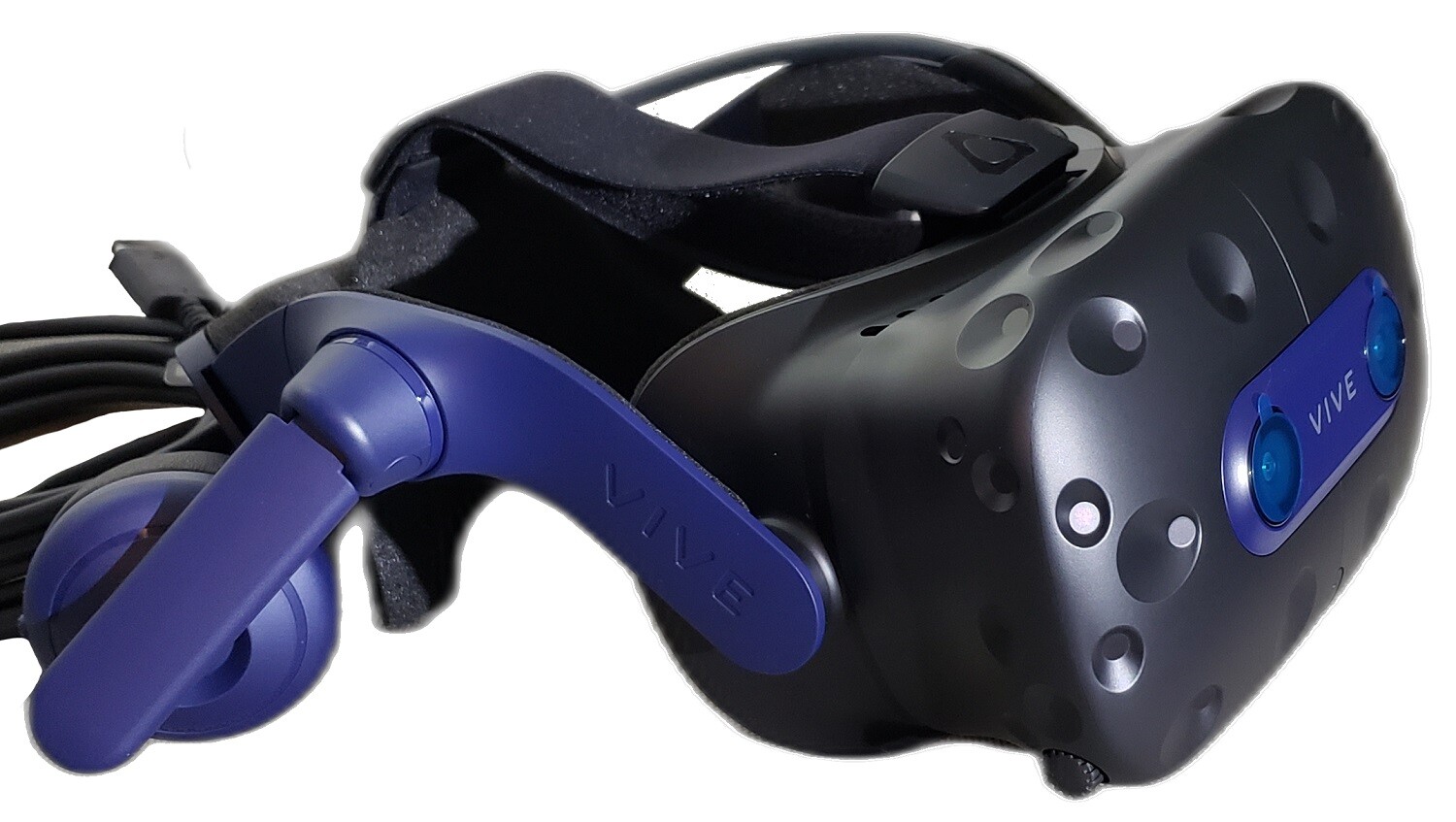
The Vive Pro 2 feels like any other VR headset ultimately – it is clearly built to minimize weight. It is known for being extremely similar in every way to the original Vive Pro aside from the screen. Compared to the Valve Index, it is noticeably more slim which is nice to see; it will protrude less from your face and is thus less susceptible to being smacked accidentally.
The padding is plush and soft, very different than the Index’s foam padding. The cushions are secured by Velcro and are easily removed and washed; the face cushion is not attached to a plastic piece like it is on the Index. It builds up a light sweat on your forehead, but since the Vive Pro 2 is far more breathable than the Index, it doesn’t cause you to sweat profusely like the Valve Index does in warmer months. The adjustable headphone arms are not the most solid feeling, but one benefit here is that they are removable if you want to use another audio solution.
One connectivity difference between the Vive Pro and Vive Pro 2 is the absence of the USB connection shown below (next to the main headset cable connection) on the Vive Pro 2:
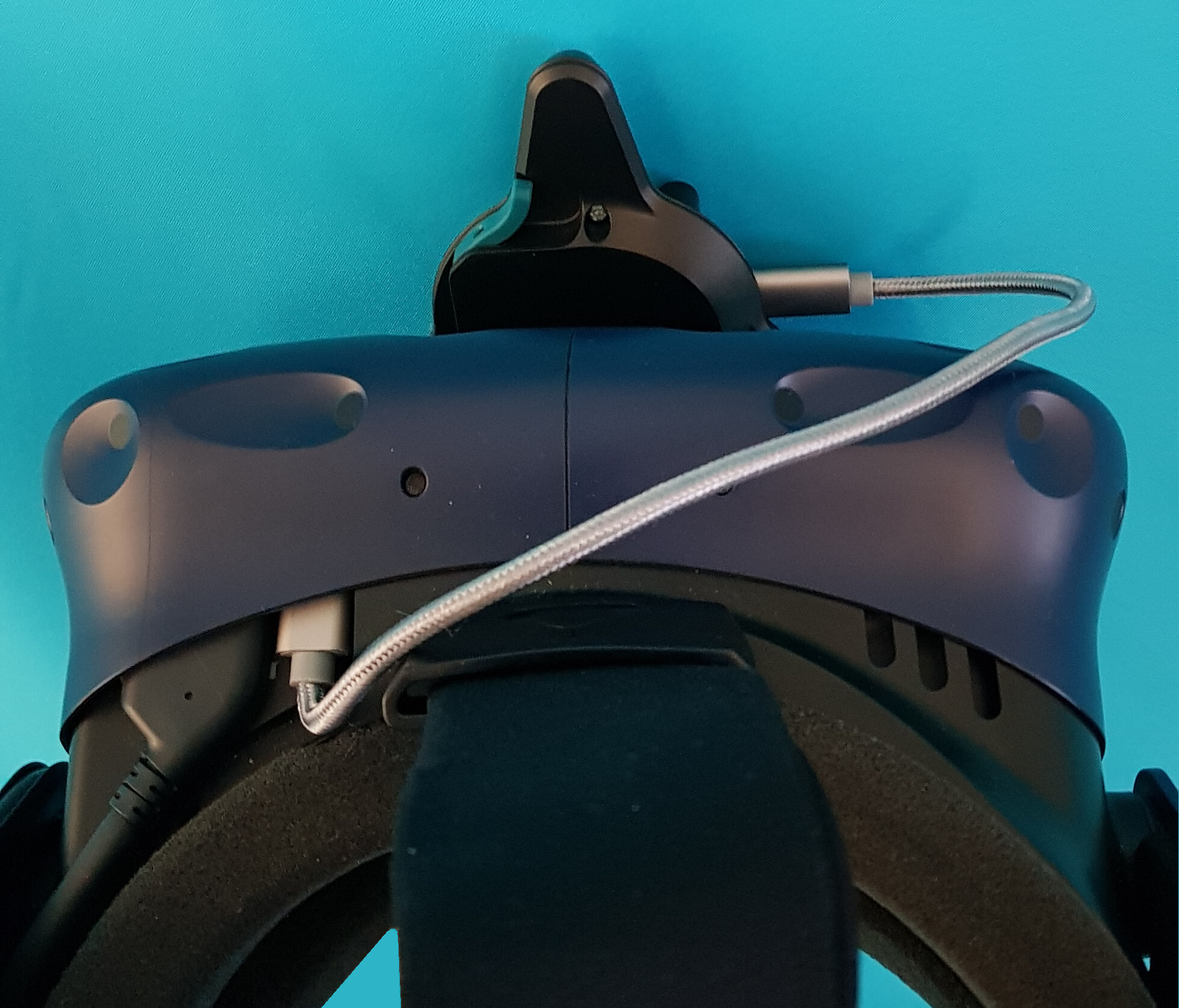
Photo by SensoryX
Adjustment range is huge, easily surpassing that of the Index, so the size of your head should be a nonissue and so should glasses. Yet at the same time, there are some comfort issues. The padding on the back of my head is higher than ideal. It takes longer to put the headset on and fit it just right compared to the Index, and if it’s just a tiny bit off (to the point where you might not notice it initially), then during intense gameplay in games like Blade & Sorcery or Boneworks, the Vive Pro 2 can move out of position for me, thus losing the focal sweet spot and requiring adjustment mid-game, which is obviously disastrous in a multiplayer game or something like Beat Saber. So be sure you have the headset on perfectly before playing.
The Vive Pro 2’s fit is very tight on my head, much tighter than the Index is for me. But at least I don’t have plastic digging into my face (middle of my brow area) like I do with the Index, however the tight fit and small pressure points it creates on my head create discomfort after 70-90 minutes of gameplay I’ve noticed.
The IPD adjustment range is typical, be sure to spend the time getting it right. The cable sleeving quality seems perhaps slightly improved over the Valve Index, but still seems susceptible to kinking on itself and wearing itself out. After about 1 year of usage, my Valve Index cable is already a mess and damaged enough to occasionally lose video signal entirely. For $799 you’d expect quality sleeving.

Setup is straightforward. You’ll want to download VIVE Console for SteamVR and do the usual setup of pairing controllers and setting up any other devices you might have. I didn’t have any issues, I simply continued using my existing SteamVR room setup.
Headset Performance
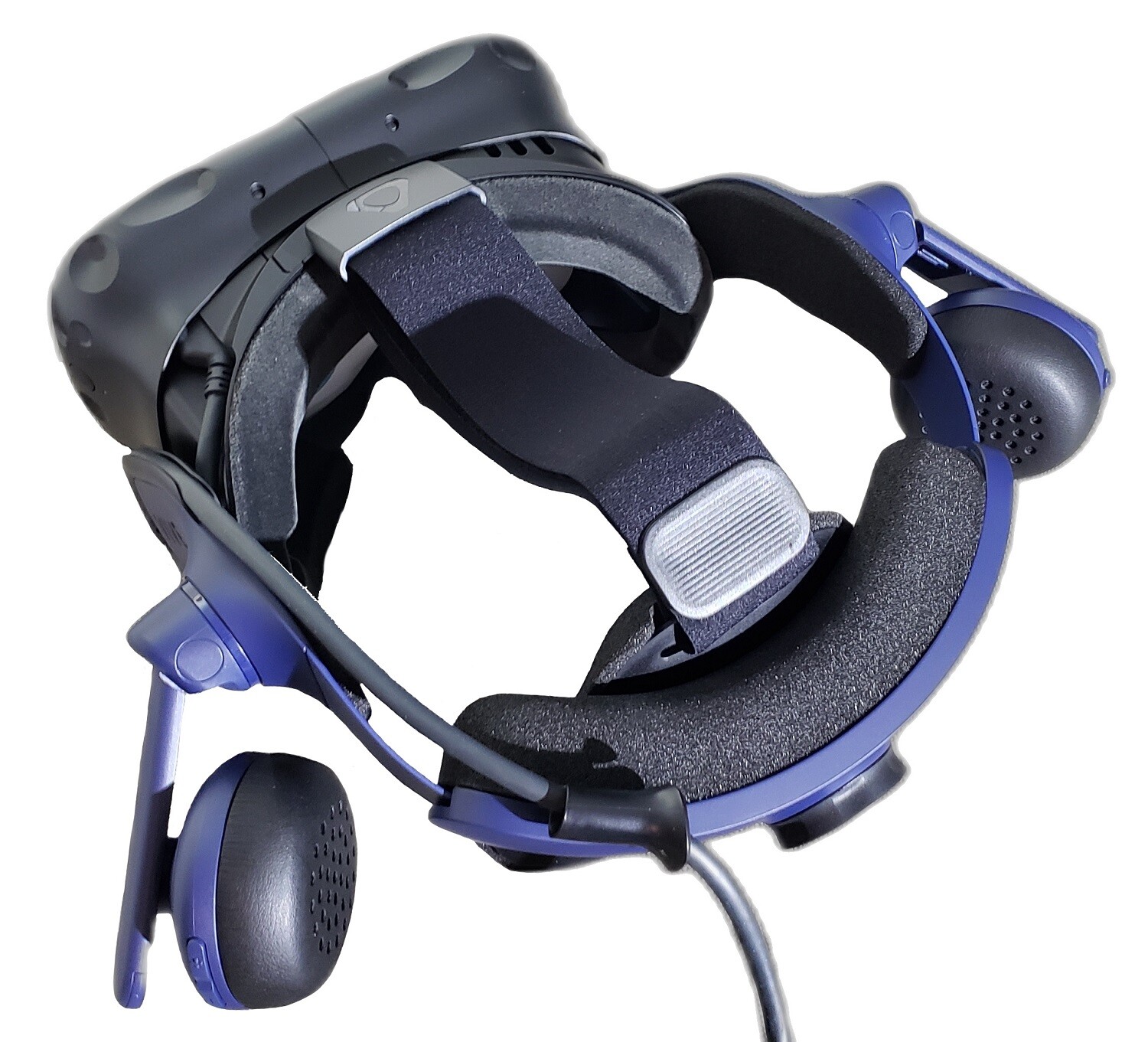
One thing others have made specific mention of is the Vive Pro 2’s focal sweet spot; the position your eyes must be relative to the screen in order to perceive it with maximum clarity. I agree with everyone else’s findings – the sweet spot is small, technically smaller than that of the Valve Index but not a substantial difference. This results in the edges of the screen being less clear, less in focus. It also means that if the headset does move during gameplay, your visual clarity will immediately be ruined, and you may very well be killed for it, so make sure you wear it properly.
Despite the small focal sweet spot, the resolution upgrade over the Valve Index is superb! It is an excellent addition to every game there is. Almost a night and day difference in clarity. It gives you a significant competitive advantage in a game like Pavlov VR, especially darker maps like the modded factory map from Escape from Tarkov – with the Valve Index and thus other 2880 x 1600 headsets and below, it’s so damn hard to see anything on this map, but with the Vive Pro 2 it’s all crystal clear.
The Vive Pro 2’s resolution is also very helpful in racing games; the increased visual clarity allows me to see the track ahead of me far better, and thus make better judgements. Actual tangible gameplay improvement, therefore it’s a bigger upgrade than going from 720p to 8k on a normal TV or monitor, since the competitive edge there is far smaller. A perfectly fitted Valve Index running at its full 2880 x 1600 resolution is still a very low resolution experience in VR, which made judging the road ahead of me difficult in racing games, which would lead to crashes if I’m unfamiliar with the course.
The massive resolution increase is also helpful for target identification in the likes of DCS World and VTOL VR. In Half-Life: Alyx, small set details are drawing my attention like they never did before, because on the Index they were too blurry. One example is the progress bar on health machines; not on the display of the device, but on the machine itself underneath the handle you pull to activate it. It never drew my attention in the Index.
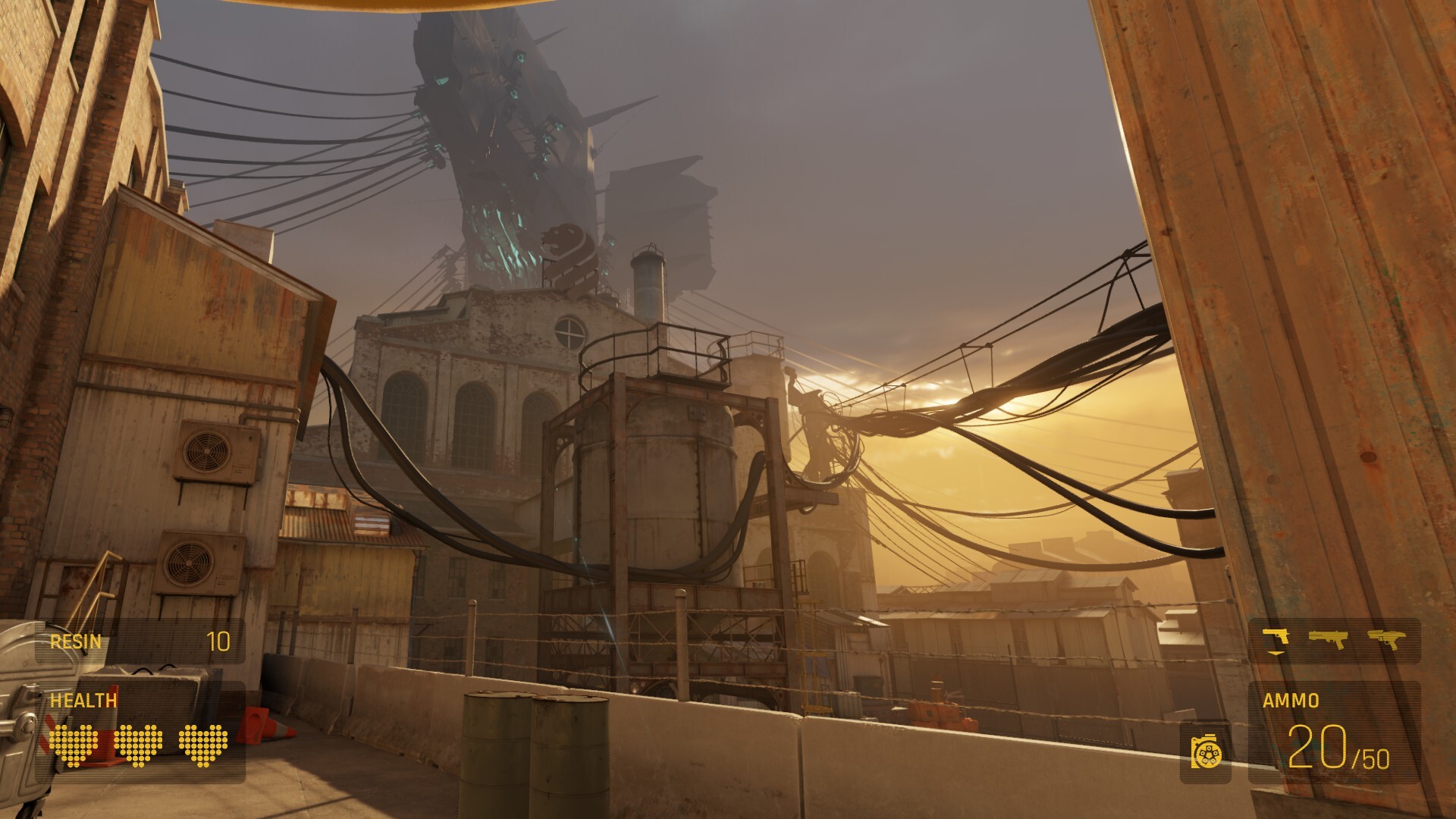
Resolution is one of the main deficiencies for most VR headsets, but after experiencing the Vive Pro 2’s 4896 x 2448 combined resolution, it’s clear that we’ve made a big leap in this critical area. I believe 8k will be the area of diminishing returns for VR resolution upgrades – Pimax 8k users sure love their resolution. That will probably require an AMD Radeon RX 9900 XT or NVIDIA GeForce RTX 6090 to run well at 90+ FPS.
The downside to the Vive Pro 2’s screen is the fact that it’s only LCD, so it’s very outdated even as far as that old technology goes (i.e. no quantum dot mini-LED here), much less the infinite contrast OLED used by its predecessor. Sure, the screen door effect was a widely reported issue for the Vive Pro, but there are other OLED subpixel designs and resolution increases will combine to help mitigate this. But again, this is not even using the latest and greatest LED display technology. Ultimately, you can’t not notice the lack of true blacks, just like on the Valve Index and every other LCD VR headset. We really need MicroLED VR headsets… and TVs, and monitors, as soon as possible.
Worse off is the inability to calibrate the screen, and most VR games don’t bother incorporating gamma or brightness controls for some reason. My Vive Pro 2 has a bit too much brightness and too little gamma correction, and nothing can really be done about it. But games not having brightness/gamma controls is inexcusable on the game creators’ behalves.

As far as field of view goes, the difference compared to the Index is not really perceivable to me. Both feel similarly narrow, improvements would be very welcome here, something Pimax focuses on (which we unfortunately lack experience with).
Sound quality is not best in class for the Vive Pro 2. The headphones are considerably worse than the Valve Index’s floating ear speakers, which provide greater clarity, dynamic range, sound stage and imaging. The microphone sounds like what you’d expect from a $15 mic. All this for $799. Come on, HTC.
As for game session duration, this is all completely subjective. Too many people don’t realize this and declare that VR gaming is only for shorter sessions. Everyone is different; I’ve had plenty of game sessions lasting over three hours in all the aforementioned racing simulators, and I’ve done it in Half-Life: Alyx as well. I’ve gone beyond two hours in The Talos Principle VR and DCS World. Not everyone experiences motion sickness, the most I get is very mild and doesn’t require a break from the action, and I only really feel it in Jetborne Racing.
But as for how the Vive Pro 2 fares here compared to the Index for me, the Index’s problem with long sessions is that it makes you sweat a lot in warmer months, while the issue with the Vive Pro 2 is the pressure points it creates on my head which becomes uncomfortable.
Thanks to the use of Base Station 2.0s and Valve Index controllers, the Vive Pro 2 lets you enjoy the best VR gaming has to offer currently with regards to tracking and interfacing. This was the goal of the Vive Pro 2 after all; provide the best of all worlds with SteamVR, high resolution, and addons. But you really have to cough up for it.
Game Performance
For this review, the system driving the HTC Vive Pro 2 comprised of a Ryzen 9 5900X, 64GB RAM, XFX Speedster MERC319 RX 6900 XT Black Edition on Rage mode, two SteamVR Base Station 2.0s from Valve and two from HTC, and Valve Index controllers.
This system is easily sufficient to run non-CPU bottlenecked VR games at 120 FPS, or even 144 FPS for better optimized games like Half-Life: Alyx, on the Valve Index using its 2880 x 1600 combined resolution. Even at max details… and yes, even in Unreal Engine 4 titles such as Assetto Corsa: Competizione, Pavlov VR, and Obduction.
Note that “non-CPU bottlenecked games” excludes probably all of the Unity engine titles, which accounts for the vast majority of VR games. Those have such poor CPU multithreading that the CPU is always bottlenecking the system and GPU usage plummets, so nothing can maintain a steady frame rate in them.
I thought that this RX 6900 XT, or the RTX 3090 it replaced, wouldn’t require reducing graphics settings with the Vive Pro 2’s 4896 x 2448 resolution, despite the massive resolution increase. I thought I’d just have to run the Vive Pro 2 at 90 Hz rather than 120 Hz, and settle for 90 FPS. Unfortunately, I overestimated the power of current gen flagship graphics cards. I got too comfortable with my performance, and 4896 x 2448 (or nearly 5k) VR brought upon a rude awakening.
With Half-Life: Alyx, I can still keep all graphics settings maxed and get 90 FPS easily. I can even get 120 FPS most of the time, but intense combat will drop it, so I stay at 90 Hz in all games. With The Talos Principle VR, which doesn’t suffer from any CPU bottlenecking but lacks VR specific optimizations, I had to bump down a few graphics settings but hardly any – I’m still running the same mix of medium, high, and ultra, and achieving 90 FPS at full resolution. That’s right, many settings have been on medium even on the Index’s small 2880 x 1600 resolution, even with the RX 6900 XT and even with the RTX 3090. This shows how important VR specific optimizations are, but more on that later.
But the Unreal Engine 4 games? Today’s poor graphics cards, even the best of them, get brutalized. My current RX 6900 XT is a tiny bit better suited to VR gaming than the RTX 3090 it replaced, but it doesn’t matter. With Assetto Corsa: Competizione, I have to drop many settings to low, and utilize resolution scaling (UE4’s TAAU) which seriously harms visual quality in VR below 90%, and even then I can’t maintain 90 FPS. I’m actually just not going to play this game until next gen graphics cards are released. I’ve benchmarked it for this review, but that’s as far as I’ll go for now. Obduction VR isn’t quite as badly affected, as nothing has to go down to low settings in order to maintain 90 FPS.
The newly released Myst remake is a bit more demanding than I expected, but with a mix of low, medium, and high settings, epic post processing setting, and forced FSR, an RX 6900 XT can maintain 90 FPS at this resolution.
I also had to lower settings considerably to Automobilista 2 and Project CARS 2, which on the Valve Index I can run maxed out at 144 FPS but on the Vive Pro 2 I have to run a mix of ultra, high, and some medium to achieve 90 FPS. DiRT Rally 2.0’s optimization stands out during this testing, as I only dropped track and crowd settings and easily hit my 90 FPS target. In DCS World, I use the VR graphics settings preset with one or two additional settings lowered, and I achieve 70-90 FPS this way. Usually it’s in the more comfortable 80-90 range.
Then there’s the VRAM usage. Assetto Corsa: Competizione, one of four Unreal Engine 4 games illustrated below, uses over 12GB VRAM. This would make the RTX 3080 Ti upset and make the RTX 3080 bleed. But Half-Life: Alyx proved to be the ultimate VRAM hog, using up to around 14.5GB in its most intense scenes like the action sequence involving the Strider. In fact, all but one of the games tested, including all Unreal Engine 4 and Unity engine games tested, use over 10GB VRAM. This resolution is too much for the RTX 3080 and its conservative 10GB VRAM.
With all of this in mind, I declare that the AMD Radeon RX 6900 XT and NVIDIA GeForce RTX 3090 are the minimum requirements for full resolution, 90 Hz gameplay with the HTC Vive Pro 2, and they’ll struggle to achieve it in many games. 16GB VRAM is also a minimum requirement for this. Anything less, even the RTX 3080 Ti and its 12GB VRAM which is what mid range cards should have rather than ultra high end (see the RX 6700 XT), and you’ll be playing at a lower output resolution. But if that’s all you have, this headset is still worth the investment over the Valve Index I say, since graphics card situations are not permanent. The Vive Pro 2 really makes me want an RX 7900 XT or RTX 4090 right about now.
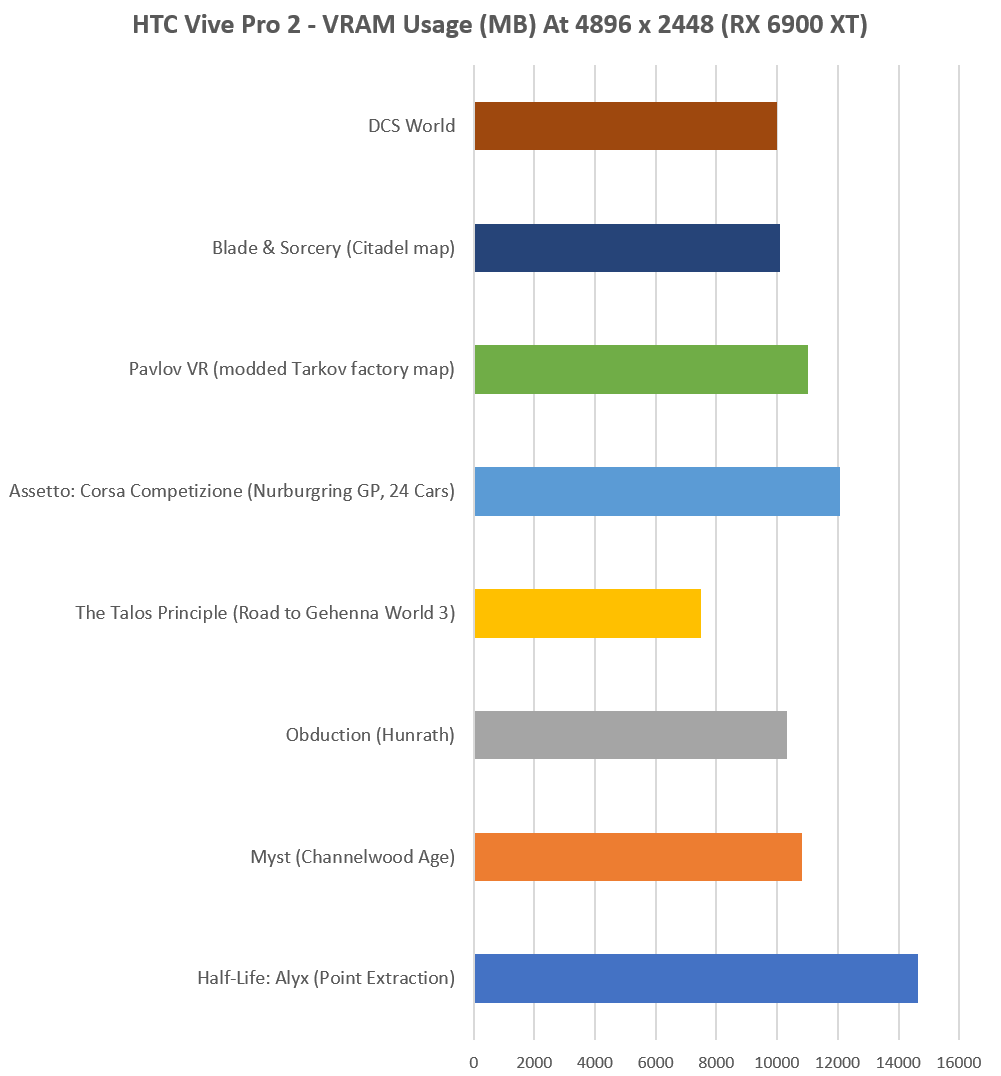
I thought going from the 144 Hz Valve Index to 90 Hz here would be a big downgrade, especially in VR, but surprisingly it wasn’t. Even in Half-Life: Alyx which ran at a stable 144 FPS on the Index, I can live with 90 FPS here, but I look forward to next generation graphics cards and being able to run 120 FPS.
Conclusion
So the question is, is the jump from a Valve Index to the Vive Pro 2 worth it? Ultimately, this depends on how much you value resolution, how much you expect eye tracking to take off (it seems like it really will), if you think you’ll be able to get your hands on the Droolon F2 and whether or not you think it’ll be good, how much you value wireless, how powerful your graphics card is and how frequently you update it. For me, I think it is worth it, even though I am still waiting on wireless and eye tracking, and even though the RX 6900 XT and RTX 3090 struggle with some games at this resolution.
I chose the Vive Pro 2 for future-proofing and to address one of the main deficiencies of last generation headsets, which is resolution. But make no mistake, the Vive Pro 2 is extremely far from perfect. As far as consumer VR headsets go, I would say the HTC Vive Pro 2 may be the best of a bad situation. Though calling it a bad situation is misleading, since VR gaming is a wonderful advancement and I wish most of my favorite games were remade in VR.
You’re really going to want at least 16GB VRAM to run the Vive Pro 2 at full resolution and 90 Hz, and next generation graphics cards are needed to run 100% of VR games comfortably at this resolution, but the RTX 3090 and RX 6900 XT can handle most of them at 90 FPS.
Pros
- The fact that it’s a SteamVR headset with outside-in tracking and Valve Index controller compatibility
- The 4896 x 2448 combined resolution which not only looks far better than 2880 x 1600 screens, it enables you to play games more effectively
- Aftermarket addons – from new pads and cushions to the HTC Vive Tracker 3.0 for full body tracking (be warned about annoying inconsistencies with these devices being detected though), Vive Wireless Adapter, Vive Facial Tracker, and hopefully the Droolon F2 soon
- Mildly improved FOV compared to the outgoing model
- Easily available replacement parts from authorized dealers unlike Valve
- Breathable design, doesn’t make you sweat profusely like the Valve Index does
Cons
- Very expensive, especially considering it doesn’t even come with eye tracking despite the fact that the Vive Pro Eye does, and considering it doesn’t come with the wireless adapter which still hasn’t been updated to support a larger resolution
- Very narrow focal sweet spot. Still, it is an extremely clear picture once properly fitted, but the edges of the screen are less clear, not unlike other headsets though.
- Screen uses out of date LCD technology with poor contrast which cannot deliver true blacks
- Mine came with too much brightness and too little gamma correction. Probably calibrated for 1.8 gamma, and because the overwhelming majority of VR “games” lack adjustments for this, I’m stuck with it. Valve Index appears calibrated for the proper 2.2 gamma.
- FOV still lower than ideal
- Inferior headphone solution compared to the Valve Index
- Poor microphone quality
- Cable sleeving quality is subpar
- Comfort issues – creates relatively small concentrated pressure points on my head that build discomfort over time. It also takes longer to fit it properly than the Index.
- Headset cable is prone to being accidentally disconnected from the Link Box
- Not a weakness of the headset, but HTC has yet to come up with a competitor to the Valve Index controller which themselves are far from perfect

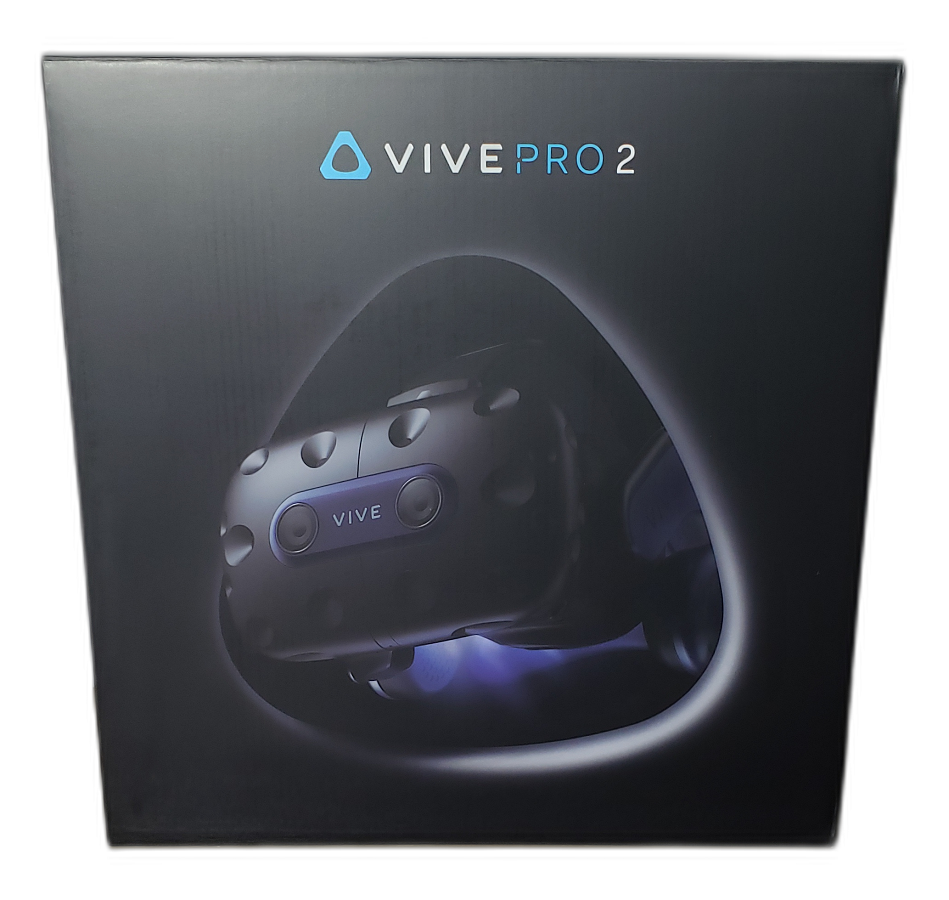


 (4 votes, average: 3.25 out of 5)
(4 votes, average: 3.25 out of 5)
I generally agree with this review, including some of the criticisms which I have raised myself. However, a couple things are a bit strange. First is the statement that the headset uses “out of date LCD technology with poor contrast.” This is a bit bizarre considering that there are no high-res OLED (let alone quantum dot mini LED) headsets on the market in this resolution league short of the $3000 (headset only with no sound) Varjo–which is not the market this headset is in. The reality is that this headset’s LCD is the cream of the crop among available VR… Read more »
Out of date from a general display technology perspective. I’m aware that HTC had no other choice, but I want to point out that the display technology is not there yet for consumer headsets.
Regarding the price, the Pimax 5k Super is also considered a competitor that costs slightly less. The Vive Pro 2 is in between them with regards to price, resolution, and refresh rate.
People will inevitably compare this to the Index and have already. You might be right about the Vive Pro 2’s position/intention, but Vive Pro 2 vs Index is a question that’s being asked anyway.